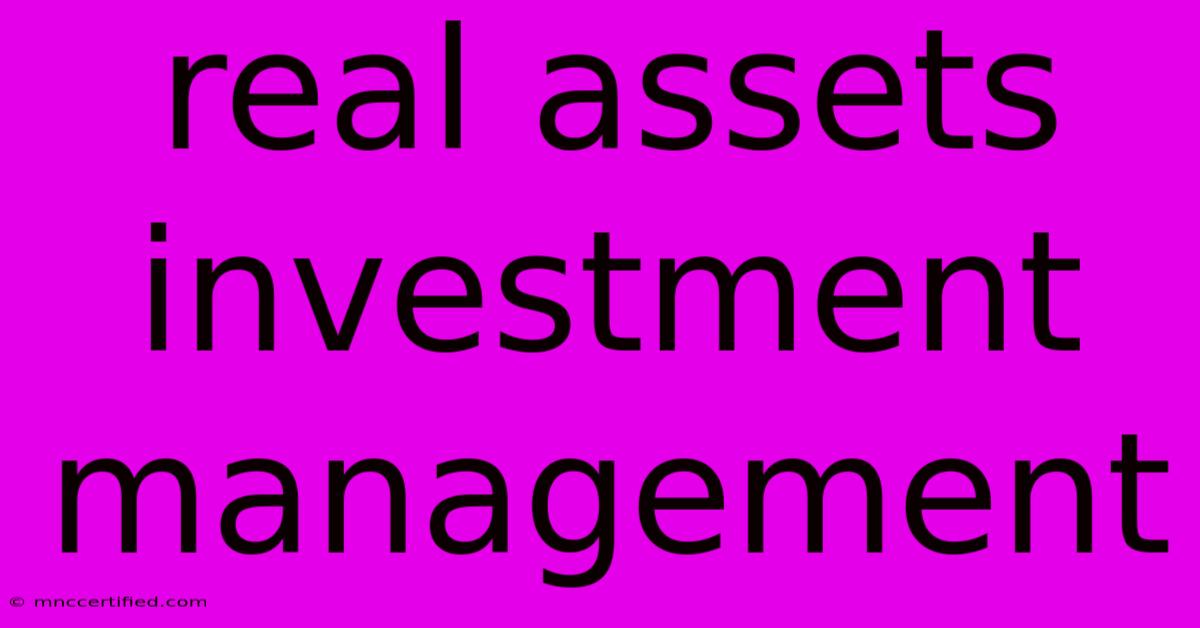Real Assets Investment Management

Table of Contents
Real Assets Investment Management: A Comprehensive Guide
Real assets investment management is a dynamic field focused on investing in tangible assets, offering diversification and potential inflation hedging benefits. Unlike traditional financial assets like stocks and bonds, real assets represent physical holdings with intrinsic value. This guide will delve into the intricacies of real assets investment management, exploring its various components and highlighting its importance in a well-rounded investment portfolio.
What are Real Assets?
Real assets encompass a broad range of tangible investments, including:
- Real Estate: Residential, commercial, and industrial properties offer rental income and potential capital appreciation. Different investment strategies exist within real estate, from direct ownership to REITs (Real Estate Investment Trusts).
- Infrastructure: Investments in transportation networks (roads, bridges, airports), utilities (water, electricity, gas), and communication systems provide stable cash flows and long-term growth prospects. This sector often involves significant capital expenditure and long-term commitments.
- Natural Resources: This includes commodities like oil, gas, gold, and timber. Investing in these assets can act as an inflation hedge and offer diversification benefits, but involves significant price volatility and geopolitical risk.
- Agriculture: Investing in farmland, livestock, or agricultural commodities offers exposure to food production and global food security. This sector is susceptible to weather patterns and regulatory changes.
- Private Equity Real Assets: This less liquid investment strategy focuses on directly investing in operating companies within the real assets sector, allowing for active management and potential higher returns but with increased risk and longer lock-up periods.
The Importance of Real Assets in Portfolio Diversification
Real assets often exhibit a low correlation with traditional financial assets, making them valuable tools for portfolio diversification. This means their price movements are less likely to mirror those of stocks and bonds, potentially reducing overall portfolio volatility and risk. This diversification is crucial for mitigating losses during market downturns. Real estate, for example, has historically demonstrated a negative correlation with equities in many markets.
Strategies in Real Assets Investment Management
Successful real assets investment management involves a multifaceted approach:
1. Due Diligence and Valuation:
Thorough due diligence is paramount. This involves assessing the underlying asset's condition, location, market demand, and potential risks. Accurate valuation is crucial for determining fair market value and investment potential. Sophisticated valuation models, incorporating discounted cash flow analysis and comparable sales data, are often employed.
2. Risk Management:
Real assets investments carry inherent risks, including market fluctuations, regulatory changes, and operational challenges. Effective risk management involves identifying, assessing, and mitigating these risks through diversification, hedging strategies, and robust due diligence processes. Understanding the specific risks associated with each asset class is crucial.
3. Active vs. Passive Management:
Investors can choose between active and passive management strategies. Active management involves actively selecting and managing individual assets, aiming to outperform market benchmarks. Passive management involves investing in diversified index funds or ETFs tracking a specific real assets index. The optimal strategy depends on the investor's risk tolerance, investment timeline, and resources.
4. Leverage and Financing:
Leverage can amplify both returns and losses. Carefully structuring financing arrangements is critical to managing financial risk. Understanding the implications of debt financing on the overall investment strategy is crucial.
The Role of Technology in Real Assets Investment Management
Technology is rapidly transforming real assets investment management. Data analytics, AI, and machine learning are being used to enhance due diligence, improve valuation models, optimize portfolio construction, and monitor risk more effectively. PropTech (Property Technology) and FinTech (Financial Technology) are driving innovation in this space.
Conclusion: Navigating the Real Assets Landscape
Real assets investment management offers a unique opportunity to diversify portfolios and potentially achieve superior risk-adjusted returns. However, it requires specialized expertise, thorough due diligence, and a robust risk management framework. By understanding the nuances of each asset class and employing sophisticated investment strategies, investors can harness the potential of real assets to achieve their long-term financial goals. Remember to always consult with qualified financial professionals before making any investment decisions.

Thank you for visiting our website wich cover about Real Assets Investment Management. We hope the information provided has been useful to you. Feel free to contact us if you have any questions or need further assistance. See you next time and dont miss to bookmark.
Featured Posts
-
Linda Mc Mahon Oz In Trumps Team
Nov 20, 2024
-
Brazil Vs Uruguay Live Stream Info
Nov 20, 2024
-
Altucher Investment Network Login
Nov 20, 2024
-
Investment Property Loans Florida
Nov 20, 2024
-
Vinicius Jr Vs Uruguay Brazil Ratings
Nov 20, 2024